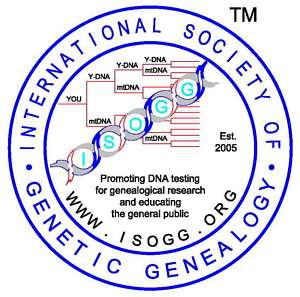Y-DNA Haplogroup C and its Subclades - 2011
The entire work is identified by the Version Number and date given on the
Main Page. Directions for citing the document are given at
the bottom of the Main
Page.
Version History Last
revision date for this specific page: 4 August 2011
Because of continuing research, the structure of the Y-DNA Haplogroup Tree changes and ISOGG
does its best to keep the tree updated with the latest developments
in the field. The viewer may observe other versions of the tree on the Web. Email
Alice Fairhurst if the differences need
clarification or if you find any broken links on this page.
C M130/Page51/RPS4Y711, M216, P184,
P255/P325, P260/P324, Page85
�
C* -
�
C1 M8, M105, M131, P122
� �
C1* -
� �
C1a P121
�
C2 M38
� �
C2* -
� �
C2a M208
� �
�
C2a* -
� �
�
C2a1 P33_1, P33_2, P33_3
� �
�
C2a2 P54
�
C3 M217, P44, PK2
� �
C3* -
� �
C3a M93
� �
C3b P39
� �
C3c M48, M77
� �
�
C3c* --
� �
�
C3c1 M86
� �
C3d M407
� �
C3e P53.1
� �
C3f P62
�
C4 M347, P309
� �
C4* -
� �
C4a M210
�
C5 M356
� �
C5* -
� �
C5a P92
�
C6 P55
NOTES:
- Identical SNPs that were discovered separately are listed in alphabetical order, not necessarily in
the order of discovery, and separated by "/". Example: M130/RPS4Y711.
Y-DNA haplogroup C appears to have arisen shortly after modern humans left Africa and
is estimated to be approximately 50,000 years old. The
haplogroup can be traced across the southern Arabian Peninsula through Pakistan and India
into Sri Lanka and Australia, and Southeast Asia.
C* is found on the Indian subcontinent, Sri Lanka and in parts of SE Asia. The rare C1 lineage
appears to be restricted to Japan. C2 is found predominantly in New Guinea, Melanesia, and
Polynesia. The successful C3 lineage is believed to have originated in southeast or central Asia,
spreading from there into northern Asia and the Americas. C3 is also found in low concentrations
in eastern and central Europe, where it may represent evidence of the westward expansion of the
Huns in the early middle ages; subhaplogroup C3b seems to be found only in the Americas.
C4 is found exclusively among aboriginal Australians and is dominant in that population.
C5 has a significant presence in India with a single instance known from Pakistan.
C6 is a recently recognized group whose geographical associations were not reported.
References:
Bortolini et al,
Y-Chromosome Evidence for Differing Ancient Demographic Histories in the Americas.
American Journal of Human Genetics, 73:524�539, (2003).
Capelli et al,
Population Structure in the Mediterranean Basin: A Y Chromosome Perspective. (pdf)
Annals of Human Genetics, 2005.
Cinnioglu et al,
Excavating Y-chromosome Haplotype Strata in Anatolia. (pdf) Human Genetics. 114:127-148, 2004.
Deng et al, Evolution
and Migration History of the Chinese Population Inferred from the Chinese Y-chromosome Evidence.
(pdf) Journal of Human Genetics, 49:339-348, 2004.
Geppert et al,
Hierarchical Y-SNP Assay to Study the Hidden Diversity and Phylogenetic Relationship of Native Populations in South America,
Forensic Science International: Genetics, 6 Oct 2010. [Epub ahead of print]
Hammer et al,
Dual Origins of the Japanese: Common Ground for Hunter-gatherer and Farmer Y Chromosomes.
(abstract) Journal of Human Genetics, 51:47-58, 2006.
Karafet et al,
New Binary Polymorphisms Reshape and Increase Resolution of the Human Y-Chromosomal Haplogroup
Tree. Abstract. Genome Research, published online April 2, 2008.
Supplementary Material.
Karafet et al,
Paternal Population History of East Asia: Sources, Patterns,
and Microevolutionary Processes. (pdf) American Journal of Human Genetics,
69:615-628, 2001.
Kayser et al,
Independent Histories of Human Y Chromosomes from Melanesia and Australia.
American Journal of Human Genetics, 68:173-190, 2001.
Kayser et al,
Melanesian and Asian Origins of Polynesians: mtDNA and Y-Chromosome Gradients across
the Pacific. MBE Advance Access published August 21, 2006.
Kayser et al.
Reduced Y-Chromosome, but Not Mitochondrial DNA, Diversity in Human Populations from West New
Guinea. American Journal of Human Genetics, 72:281-302, 2003.
Kivisild et al,
The Genetic Heritage of the Earliest Settlers Persists in both Indian Tribal and Caste
Populations. (pdf) American Journal of Human Genetics, 72:313-332, 2003.
Mohyuddin et al,
Detection of Novel Y SNPs Provides Further Insights into Y Chromosomal Variation in Pakistan.
Journal of Human Genetics, 2006.
Mona et al,
Patterns of Y-chromosome Diversity Intersect with the Trans-New Guinea Hypothesis.
Mol Biol Evol. 2007 Sep 10; [Epub ahead of print]
Pakendorf et al,
Investigating the Effects of Prehistoric Migrations in Siberia: Genetic Variation and the Origins of Yakuts,
Human Genetics, Volume 120, Number 3, 334-353, 2006.
Regueiro et al,
Iran: Tricontinetnal Nexus for Y-Chromosome Driven Migration. (abstract)
Human Heredity, Vol. 61, No 3, 132-143, 2006.
Rozen et al,
Remarkably Little Variation in Proteins Encoded by the Y Chromosome's Single-Copy Genes, Implying Effective
Purifying Selection. American Journal of Human Genetics. 2009 December 11; 85(6): 923-928.
Scheinfeldt et al,
Unexpected NRY Chromosome Variation in Northern Island Melanesia. (Link and comments from
Dienekes' Anthropological Blog) Society for Molecular Biology, 2006.
Sengupta et al,
Polarity and Temporality of High Resolution Y-chromosome Distributions in India
Identify Both Indigenous and Exogenous Expansions and Reveal Minor Genetic Influence
of Central Asian Pastoralists. (pdf)
American Journal of Human Genetics, 78:202-221, 2006.
Underhill et al,
Use of Y Chromosome and Mitochondrial DNA Population Structure in Tracing Human Migrations. (abstract)
Annual Review Genetics, 41:539-564, December 1, 2007(a).
Additional Resources:
ISOGG Wiki - What you need to know about Genetic Genealogy.
C/C3 Haplogroup, Ed Martin.
Corrections/Additions made since 1 January 2011:
- Added Page85 on 11 March 2011.
- Added Rozen et al (2009) on 24 March 2011.
- Added Page51 on 30 March 2011.
- Added extensions such as _1, _2, _3 to snps with multiple y-positions on 4 August 2011.
Contact Person for Haplogroup C: David Reynolds

